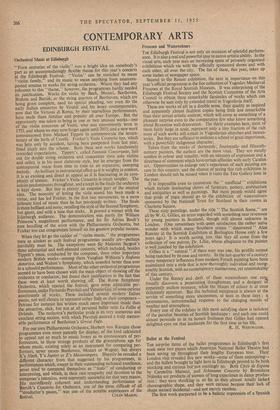Frescoes and Watercolours
THE Edinburgh Festival is not only an occasion of splendid perform- ance. It is also a real and powerful spur to native artistic ability. In the visual arts, each year sees an increasing spate of privately organised exhibitions which vie with ' the officially sponsored shows and with each other, all over the city. The list of these, this year, takes up some inches of newspaper space.
Second to the Renoir exhibition, the next in importance on this year's official programme is the fine collection•of Yugoslav Mediaeval Frescoes at the Royal Scottish Museum. It was enterprising of the Edinburgh Festival Society and the Scottish Committee of the Arts Council to obtain these remarkable facsimiles of works which can otherwise be seen only by extended travel in Yugoslavia itself.
These are works of art in a double sense, their quality as inspired and apparently almost faultless copies being little less remarkable than their actual artistic content, which will come as something of a pleasant surprise even to the comparative few who know something about Byzantine wall-decoration. The thirty examples here, most of them fairly large in scale, represent only a tiny fraction of the rich store of such works still extant in Yugoslavian churches and monas- teries. But they are sufficient to indicate a school of great importance, with a powerfully indigenous character.
Taken from the works of thirteenth-, fourteenth- and fifteenth- century painters, the earliest are the most vital. They are mostly sombre in colour and tonality, with an intensity of expression and a directness of statement which have certain affinities with early Catalan art. Opportunitiei to enlarge one's experience of such painting are rare in this country, and the chance of seeing this rich exhibition in London should not be missed when it visits the Tate Gallery later in the year.
It is impossible even to enumerate the " unofficial " exhibitions which include fascinating shows of furniture, pottery, architecture and antiquities as well as paintings. But most people would agree that pride of place should go to the exhibition of watercolours sponsored by the National Trust for Scotland in their rooms in Charlotte Square.
These sixty paintings, under the title " The Scottish Scene," are all by W. G. Gillies, an artist regarded with something near reverence by young painters in Scotland, though still almost unknown in London. (One remembers with quiet satisfaction the rather naive wonder with which many Southern critics " discovered " Alan Ramsay at the Scottish Exhibition at Burlington House only a few years ago.) It is worth noting, too, that they all come from the collection of one patron, Dr. Lillie, whose allegiance to the painter is well justified by the exhibition.
Gillies is a " natural " if there ever was one, his prolific output being matched by its ease and variety. In the last quarter of a century many temporary influences from modern French painting have been assimilated into a style that is now thoroughly individual and recog- nisably Scottish, with no contemporary mannerisms, yet unmistakably of this century. Under the fluency and dash of these watercolours one con- tinually discovers a penetrating draughtsman and a designer a apparently endless resource, while the bloom of colour is at once deliciously apparent. But the technical equipment is always at the service of something more uncommon, at least in these days ; a spontaneous, untrammelled response to the changing moods of weather and atmosphere. Every one of the exhibits in this most satisfying show is redolent of the peculiar beauties of Scottish landscape ; and each one could almost persuade us in its honest freshness that Gillies had opened delighted eyes on that landscape for the first time in'his life.
R. H. WESTWATER.


































 Previous page
Previous page